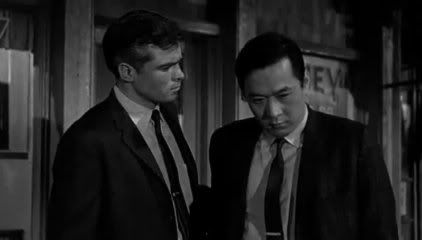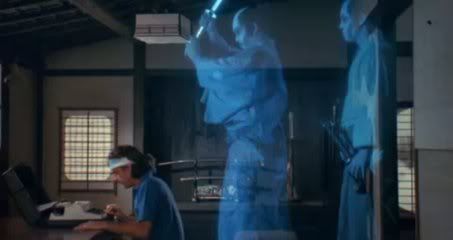I don't know about the Japanese, but this American thinks you look fabulous.

Had a double feature of Japanese-centric movies today. The first, 1959's The Crimson Kimono, was written, produced and directed by Samuel Fuller and is set in and around Los Angeles's Little Tokyo. The second, 1982's The House Where Evil Dwells, is about a family that goes to Japan and moves into a house in Kyoto that is haunted by vengeful spirits. The two couldn't be more different (in retrospect, The House Where Evil Dwells probably would have gone better with The Yakuza), but I suppose I'm used to switching gears like this.
The main plot of The Crimson Kimono involves the investigation into the murder of a burlesque dancer named Sugar Touch by a pair of police detectives, all-American-type Glenn Corbett and Japanese-American James Shigeta, who have a history going back to Korea, where they fought side-by-side. Since the war they've been inseparable, moving into a sprawling apartment together and even practicing kendo with each other, but when their investigation brings them into the orbit of art student Victoria Shaw and they both fall for her, well, the writing is practically on the wall for their friendship. The film also features Anna Lee as the older -- and much wiser -- Mac, a painter who recognizes Shaw's talent and can tell that Corbett and Shigeta are headed for a split over her, and Neyle Morrow (a familiar face from Fuller's Shock Corridor and The Steel Helmet) as a menacing figure and one of the keys to their investigation.
Fuller enjoyed injecting social issues into his films and this one was no different. Just as he would do in 1982's White Dog, he tackled the subject of racism head on as Shigeta comes to believe that everyone -- old friends and new lovers alike -- is judging him based on his Japaneseness. Fuller's dialogue can be a bit on-the-nose at times -- and as Curtis Hanson says in the interview included on the DVD, nobody in real life talked the way his characters did except for Fuller himself -- but with his bluntness comes an absolute sincerity that can't be faked.

In contrast, there's very little about The House Where Evil Dwells that can be taken at face value. Directed by Kevin Connor, who previously helmed 1980's Motel Hell as well as a series of films in the '70s based on the works of Edgar Rice Burroughs, the film opens with a prologue set in 1840 where a samurai kills his wife and her lover when he catches them fooling around and then turns the blade on himself. Fast-forward 142 years as mustachioed writer Edward Albert (fresh from conquering the Galaxy of Terror) and his wife (Susan George of Straw Dogs fame/infamy) and daughter (Amy Barrett) arrive in the country and are set up in the house by friend and American consul Doug McClure, who tells them they got it cheap (roughly $250 a month) because it's supposedly haunted, but Albert is undeterred and moves them right in. (I guess they hadn't seen Burnt Offerings when it came out six years earlier or they would have known that was a deal-breaker.)
As if to spite him, strange things start happening almost immediately and it isn't long before Connor actually shows the Japanese spirits moving things around and the wife possessing George, getting her to initiate an affair with McClure. Meanwhile, the wife also begins appearing to Albert through the lens of his camera (but doesn't show up when the photos are developed) and nearly drowns him when he falls into the water on an assignment. Barrett isn't immune, either, since she sees the slain lover's face in her soup one night (shades of the "In a Cup of Tea" story from 1964's Kwaidan) and is menaced by some silly-looking crab puppets the next night. Finally she gets packed off to the States so Albert, George and McClure can all get possessed at the same time and the ghosts can have it out once and for all -- or until the next time the house is rented out.
I knew going in that this wasn't going to be a classic (Videohound's Horror Show gave it one-and-a-half bones, CineBooks' The Horror Film gave it one-and-a-half stars, and John Stanley's Creature Features Movie Guide called it "lackluster" and "predictable"), but it was on TCM right after Burnt Offerings and reminded me of the lesser-known second feature Joe Bob Briggs frequently had on MonsterVision back in the day. In that vein, here are the Drive-In Totals: Four breasts. Six dead bodies. Two quarts blood. Multiple aardvarking. Multiple stabbings. Arm rolls. Heads roll. Gazebos roll. Intestines roll. Kung fu. Sword fu. Giant crab fu. Drive-In Academy Award nominations for nobody. One-and-a-half stars. (Why buck the trend?) Craig J. says don't check it out.